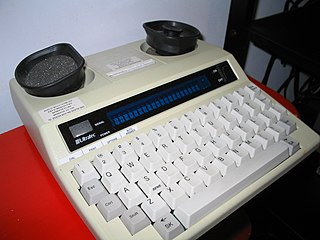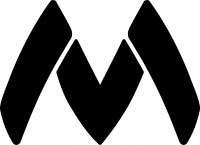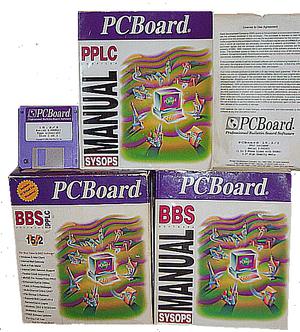
A bulletin board system (BBS), also called a computer bulletin board service (CBBS), was a computer server running software that allowed users to connect to the system using a terminal program. Once logged in, the user could perform functions such as uploading and downloading software and data, reading news and bulletins, and exchanging messages with other users through public message boards and sometimes via direct chatting. In the early 1980s, message networks such as FidoNet were developed to provide services such as NetMail, which is similar to internet-based email.
FidoNet is a worldwide computer network that is used for communication between bulletin board systems (BBSes). It uses a store-and-forward system to exchange private (email) and public (forum) messages between the BBSes in the network, as well as other files and protocols in some cases.

In telecommunications, an acoustic coupler is an interface device for coupling electrical signals by acoustical means—usually into and out of a telephone.

The Hayes command set is a specific command language originally developed by Dale Heatherington and Dennis Hayes for the Hayes Smartmodem 300 baud modem in 1981.
UUCP is a suite of computer programs and protocols allowing remote execution of commands and transfer of files, email and netnews between computers.

CBBS was a computer program created by Ward Christensen and Randy Suess to allow them and other computer hobbyists to exchange information between each other.
An online service provider (OSP) can, for example, be an Internet service provider, an email provider, a news provider (press), an entertainment provider, a search engine, an e-commerce site, an online banking site, a health site, an official government site, social media, a wiki, or a Usenet newsgroup.

A telecommunications device for the deaf (TDD) is a teleprinter, an electronic device for text communication over a telephone line, that is designed for use by persons with hearing or speech difficulties. Other names for the device include teletypewriter (TTY), textphone, and minicom.

MindVox was an early Internet service provider in New York City. The service was referred to as "the Hells Angels of Cyberspace".
Hayes Microcomputer Products was a US-based manufacturer of modems. The company is known for the Smartmodem, which introduced a control language for operating the functions of the modem via the serial interface, in contrast to manual operation with front-panel switches. This smart modem approach dramatically simplified and automated operation. Today almost all modems use a variant of the Hayes command set.
Synchronet is a multiplatform BBS software package, with current ports for Microsoft Windows, Linux, and BSD variants. Past versions also ran on MS-DOS and OS/2, but support for those platforms were dropped in version 3.0.
The Bread Board System (TBBS) is a multiline MS-DOS based commercial bulletin board system software package written in 1983 by Philip L. Becker. He originally created the software as the result of a poker game with friends that were praising the BBS software created by Ward Christensen. Becker said he could do better and founded eSoft, Inc. in 1984 based on the strength of TBBS sales.

PCBoard (PCB) was a bulletin board system (BBS) application first introduced for DOS in 1983 by Clark Development Company. Clark Development was founded by Fred Clark. PCBoard was one of the first commercial BBS packages for DOS systems, and was considered one of the "high end" packages during the rapid expansion of BBS systems in the early 1990s. Like many BBS companies, the rise of the Internet starting around 1994 led to serious downturns in fortunes, and Clark Development went bankrupt in 1997. Most PCB sales were of two-line licenses; additional line licenses were also available.

Punter is a protocol for file transfer developed in the 1980s by Steve Punter. There are various types of Punter such as PET Transfer Protocol (PTP), C1 and C2.

Novation, Inc., is an early modem manufacturer whose CAT series were popular in the early home computer market in the late 1970s and early 1980s, notably on the Apple II. The Hayes Smartmodem 300, introduced in 1981, helped kill off Novation and many other early modem companies over the next few years.
OSUNY was a dial-up bulletin board that was run by two different sysops in the 1980s, "Sysop" while in Scarsdale, New York, and Frank Roberts in White Plains, New York. Named for the Ohio Scientific computer it originally ran on, it attracted a large group of hackers, phone phreaks, engineers, computer programmers, and other technophiles. It remained a haven almost exclusively for the hacker/phreaker community until gaining notoriety through mention in a Newsweek article, Hacking Through NASA: A threat- or only an embarrassment, and mention in the book The Hacker Crackdown as a favored hangout of the notorious hacker group The Legion of Doom, after which it was shuttered, and another board was brought up as a "replacement" known as The Crystal Palace, which was short-lived. OSUNY was restarted soon after, using an Altos 5-15D running MP/M and the continuously evolving Citadel/UX software. Also in the mid-1980s it became the first BBS to be associated with 2600 Magazine. It ran via dial-up until its closing around 1988.
ASCII Express, also known as AE, is a telecommunications software developed specifically for the Apple II series of personal computers. Throughout the 1980s, ASCII Express garnered a reputation as the preferred programme among telecommunications enthusiasts and users. Its functionality and compatibility with the Apple II made it a staple in the early computer communications era.
GT Power is a bulletin board system (BBS) and dial-up telecommunications/terminal application for MS-DOS. It was first introduced in the 1980s by P & M Software, founded by Paul Meiners. GT Power can be used both to host a BBS as well as to connect to other BBS systems via its full-featured dial-up "terminal mode". GT Power was a shareware package that required a registration fee in order to access its proprietary network mail transport/handling software and, by default, the GT Power Network. The software is distributed in two "flavors": a terminal-only version, nicknamed GTO, and the full-featured host and terminal version.
StarDoc 134 is a Dos/Linux hybrid BBS running EleBBS maintained by Andrew Baker aka "RamMan, Dotel and Dotelpenguin".

A modulator-demodulator or most commonly referred to as modem is a computer hardware device that converts data from a digital format into a format suitable for an analog transmission medium such as telephone or radio. A modem transmits data by modulating one or more carrier wave signals to encode digital information, while the receiver demodulates the signal to recreate the original digital information. The goal is to produce a signal that can be transmitted easily and decoded reliably. Modems can be used with almost any means of transmitting analog signals, from light-emitting diodes to radio.









